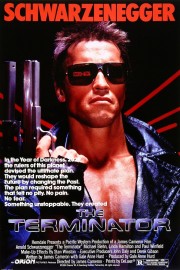The Terminator
When you watch the first “Terminator,” it’s both a perfect distillation of cinema of the ’80s, with it’s excesses and sometimes cheesy production values, as well as the antithesis of ’80s cinema. On the surface, it’s very much a big, loud ’80s action movie, but co-writer/director James Cameron has much more on his mind than just blowing shit up. As we’re seeing now as he returns to Pandora and the world of “Avatar,” Cameron is a big canvas filmmaker who has no small ideas. With this 107-minute thrill ride, he lays out an intriguing mythology with time travel, destiny and nuclear holocaust at it’s center that gives us more to think about than a lot of ’80s action films did. How intriguing has this mythology been? Thirty one years later, we’re on our third cinematic attempt to expand on this world since Cameron left it behind after 1991’s “Terminator 2: Judgement Day.” While the jury is still out with me on the latest attempt, “Terminator Genisys,” I can tell you that, while they both had selling points, neither “Terminator: Rise of the Machines” and “Terminator: Salvation” came close to invalidating Cameron’s decision to walk away from the franchise.
The story, pretty much everyone knows by now. The film begins on a shot of machines rolling around over human skeletons. War has come to Earth, which is a nuclear wasteland. Words come on the screen referring to machines rising up, and laying waste to humanity, unless the future can be saved…in the past. Cut to present day Los Angeles, and a workman comes across an electrical anomaly that seems to produce a naked man, a muscled man (Arnold Schwarzenegger), who promptly begins leaving a violence in his wake to get clothes, and what he needs. At another place in the city, the same thing happens, but with a more regular-looking individual (Michael Biehn). He’s not as drawn to violent confrontation, but he has a mission, as well. We come to find out that they’re looking for the same person: a woman named Sarah Connor, although when they look in the phone book, there are multiple ones listed. The one they’re after (played by Linda Hamilton) is young and works at a restaurant, and when this pattern comes to her knowledge, she’s scared. Thankfully, Kyle Reese (Biehn’s character) finds Sarah first, and is able to save her from the Terminator (Schwarzenegger) sent to kill her. From there, the film becomes a chase for the fate of the future; Sarah, it turns out, is the mother of John Connor, who would become the leader of the human resistance to the machines. For a 19-year-old, this is a lot to take in.
Cameron’s film moves at a breakneck pace, with no dead weight involved in any scene we’re shown. The score, by Brad Fiedel, illustrates than from the first beats of it’s iconic theme. Synthesizers and percussion were becoming a big part of the film music landscape in the ’80s, and Fiedel’s score for this film is one of the finest examples of that. The theme is heard in a variety of ways, with a tender rendition when Sarah and Reese make love mid film to a heroic rendition during the opening credits and a suspenseful one when Arnold’s Terminator is on hunt for Sarah and Reese. Fiedel’s synthesized orchestrations are ideal for a film that’s brutal and gripping as it tells a kind of absurd story, even by time travel logic. The reason it works is, first and foremost, thanks to Cameron’s relentless pacing and storytelling. Though he would tell longer stories in later years, and the multiple versions for “T2” are the stuff of legends to rival “Blade Runner,” Cameron always has a clear eye to the story that needs told, and that’s never been more obvious than on “Terminator.” He had previously shared a directing credit on the feature, “Piranha Part Two: The Spawning,” but this is Cameron’s real debut, and it signals everything we’ve come to associate with the filmmaker– tight pacing, expert action direction, imaginative visual effects (with Stan Winston providing memorable stop-motion work), and most important, a tough female lead in Hamilton’s Sarah Connor, although she would really come into her own, on that front, in “T2.” His and Gale Anne Hurd’s screenplay for this film is a model for action writing while also satisfying fans of science fiction cinema, as well. This is intelligent, exciting, and sometimes emotional filmmaking, which is what we’ve come to expect from Cameron, and what nobody saw coming in the ’80s, when a muscled lead character with a monosyllabic vocabulary (which Cameron utilizes for maximum suspense, and comedy, in his first collaboration with Schwarzenegger) in a non-stop action movie meant checking your brain at the door, and just enjoying the fireworks. For Cameron, you had to bring your head into the game, as well, and the result is a classic in every sense of the word.










